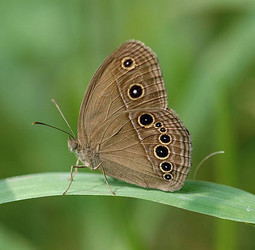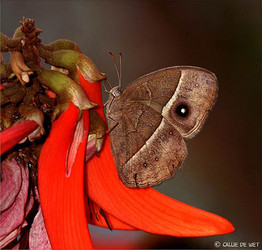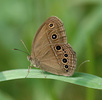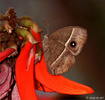Mycalesina
Andrew V. Z. Brower- Bicyclus (Bushbrowns)
- Hallelesis
- Heteropsis (Forest Patrollers)
- Lohora (Sulawesi Bushbrowns)
- Nirvanopsis (incertae sedis)
- Mycalesis (Bushbrowns) (monophyly uncertain)
Discussion of Phylogenetic Relationships
Torres et al. (2001) published a molecular phylogenetic hypothesis for a number of Madagascan taxa, based on short regions of COII and cytB. However, their cladogram suggested the reciprocal paraphyly of Henotesia and Bicyclus, as well as the embedding of Mycalesis francisca well within Henotesia. Due to its drastic implications for the current understanding of mycalesine taxonomy, this topology is not presented, pending the accumulation of additional evidence.
References
Ackery PR, Smith CR, and Vane-Wright RI eds. 1995. Carcasson's African butterflies. Canberra: CSIRO.
Torres E, Lees DC, Vane-Wright RI, Kremen C, Leonard JA, and Wayne RK. 2001. Examining monophyly in a large radiation of Madagascan butterflies (Lepidoptera: Satyrinae: Mycalesina) based on mitochondrial DNA data. Mol. Phylogenet. Evol. 20: 460-473.
Vane-Wright RI and De Jong R. 2003. The butterflies of Sulawesi: annotated checklist for a critical island fauna. Zoologische Verhandelingen 343, 1-267.
Title Illustrations

| Scientific Name | Mycalesis perseus blasius |
|---|---|
| Specimen Condition | Live Specimen |
| Source | pic09 |
| Source Collection | Flickr |
| Image Use |
 This media file is licensed under the Creative Commons Attribution-NonCommercial-ShareAlike License - Version 2.0. This media file is licensed under the Creative Commons Attribution-NonCommercial-ShareAlike License - Version 2.0.
|
| Copyright | © 2005 Weiting Liu |
| Scientific Name | Bicyclus safitza |
|---|---|
| Location | Africa |
| Comments | Common Bush Brown Bicyclus safitza safitza , (Hewitson, 1851), Family Satyrinae – Wingspan M 40-43 cm, F 45-48 cm. The flower is from an Erythrina or Coral tree family. This is the most common brown b’fly in Africa & found almost anywhere where forests and thick vegetation occur. The M is dark brown, the F slightly lighter. Both have the eye-spots on the upperside of the forewing, often indistinct and also eye-spots on the underside of the forewing & also sometimes on the hindwing. They fly throughout the year, more in summer than in winter, & summer forms are more distinctly marked than their winter counterparts. Its flight is weak and floppy, and it seldom flies long. It looks like a dead leaf when settled on the leafy foliage of the forest floor. |
| Specimen Condition | Live Specimen |
| Source | COMMON BUSH BROWN |
| Source Collection | Flickr |
| Copyright |
© 2006 Callie de Wet

|
About This Page

Middle Tennessee State University, Murfreesboro, Tennessee, USA
Correspondence regarding this page should be directed to Andrew V. Z. Brower at
Page copyright © 2006
 Page: Tree of Life
Mycalesina .
Authored by
Andrew V. Z. Brower.
The TEXT of this page is licensed under the
Creative Commons Attribution License - Version 3.0. Note that images and other media
featured on this page are each governed by their own license, and they may or may not be available
for reuse. Click on an image or a media link to access the media data window, which provides the
relevant licensing information. For the general terms and conditions of ToL material reuse and
redistribution, please see the Tree of Life Copyright
Policies.
Page: Tree of Life
Mycalesina .
Authored by
Andrew V. Z. Brower.
The TEXT of this page is licensed under the
Creative Commons Attribution License - Version 3.0. Note that images and other media
featured on this page are each governed by their own license, and they may or may not be available
for reuse. Click on an image or a media link to access the media data window, which provides the
relevant licensing information. For the general terms and conditions of ToL material reuse and
redistribution, please see the Tree of Life Copyright
Policies.
- First online 09 November 2006
- Content changed 09 December 2006
Citing this page:
Brower, Andrew V. Z. 2006. Mycalesina . Version 09 December 2006 (under construction). http://tolweb.org/Mycalesina/70799/2006.12.09 in The Tree of Life Web Project, http://tolweb.org/










 Go to quick links
Go to quick search
Go to navigation for this section of the ToL site
Go to detailed links for the ToL site
Go to quick links
Go to quick search
Go to navigation for this section of the ToL site
Go to detailed links for the ToL site